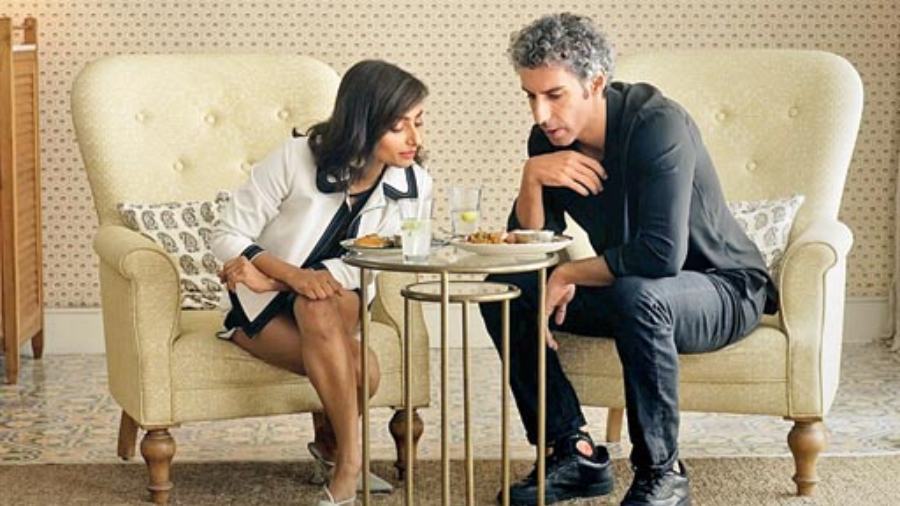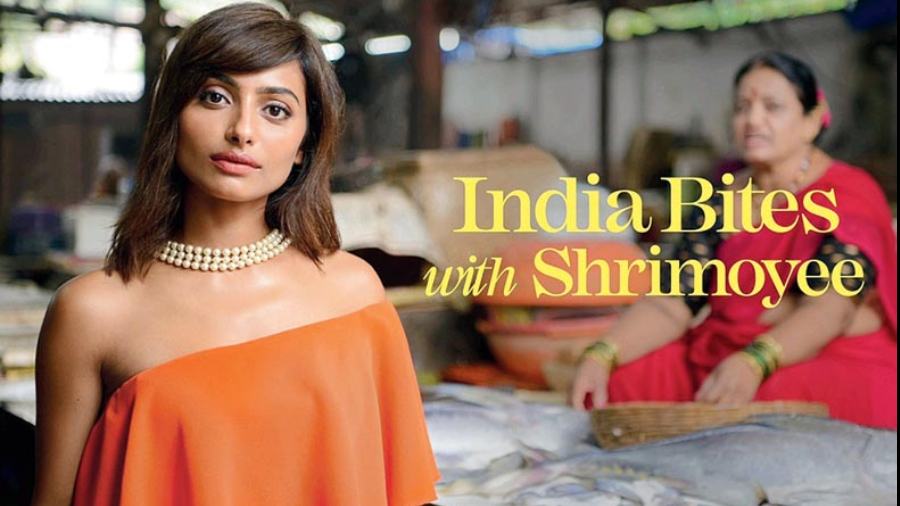Shrimoyee Chakraborty’s energy and verve is infectious. And, as you go deeper into a conversation with the presenter, producer and chef, there’s no way you will not be inspired. Fiery, candid and oh-so-cool. We recently caught up with Shrimoyee to chat with her about her five-part docu-series India Bites that is airing on Tastemade and can be streamed on platforms including Samsung TV Plus, The Roku Channel, Amazon FreeVee, DirectTV Stream, and TV Now, that marks her debut on TV. The series has been produced by Tastemade and Bagh Films Limited. “Even British Indians don’t know what India today really is because they are living in this old, archaic idea of India. Indians in India have evolved a lot more... is my personal take,” said Shrimoyee. India Bites is all about India through her eyes.
“There will be multiple seasons. Season One was about showing the cities I grew up in, Kolkata and Mumbai. A lot of Kolkata actually and I am very proud of that,” said the petite fireball who was born in Rishra, then moved to South Kolkata in Gariahat when she was about 14-15, pursued her undergraduation in Mumbai and then moved to London for her post-graduation. At 25, she had her restaurant Calcutta Street in London. Her parents still live in Kolkata. Excerpts from our adda.
Have you always been this candid or is this the Bengali gene?
I think it is the Bengali gene for sure. I think I have been too candid since I was a child. Nothing was scripted (for the show)!
For India Bites, where did you start from when it came to Kolkata?
The Kolkata that I remember and grew up in. Southern Avenue, we went to Park Street, we shot north Kolkata, Dalhousie.... I also tried to show a bit of modern Kolkata. So, we went to Chinatown and we showed Tiretta Bazar but we also showed Skinny Mo’s which is a jazz bar. Glenburn Penthouse features. We shot inside Jadavpur University.
Everybody is showing Kolkata in this north Kolkata space, which is great, but I also wanted to show what the modern Bong is doing. There is a big section about jazz music in Kolkata. We also talk about the pub culture that actually came about from Kolkata.... I showed the Kolkata gay scene which is really amazing. I had Dev R Nil’s Nil there... how progressive Kolkata is in terms of accepting homosexuality....
There is a whole episode on Bengali home food, where we show fish and also talk about the widow recipes. Indo-Chinese food features a lot. Then we have a whole section on rolls, Kolkata Kathi Rolls. I have featured Mouchak in it, the mishtis and the Nahoum bakery. We show the cake and tea culture of Kolkata... how Darjeeling tea is as expensive as champagne....
Episode One is about the ‘Melting Pot of Culture’. Episode Two is about the music scene in India and Indo-Chinese food where you have Imaad (Shah), Neel Adhikari... a lot of Bongs appear in the show. Ishaan Ghose, Goutam Ghose’s son, edited two of my episodes, Soutrik Chakraborty did the music, all my editors were Bongs... a lot of the cast was also Bengali.
Anything you wanted to feature but couldn’t find?
I really wanted to feature chhatu makha... bel er sherbet... I wish I could have shown those because those are the superfoods of today and though we did manage to shoot some, it wasn’t meaty enough to come up. How chhatu is now being had by Gwyneth Paltrow and we have heard about chhatu since we were babies! How the worker’s breakfast has reached Vogue USA....
What part of Kolkata surprised you?
I left India when I was 19. So, I wasn’t that connected... what I was pleasantly surprised with was the ideas like ‘Bengalis are lazy’ or ‘entrepreneurship is not happening’ are not correct any more. I also see how a lot of Bengalis are coming back to Kolkata and starting start-ups. I feel so proud when I see them in Goa or somewhere else. We have always been in the creative space, but somehow, we haven’t monetised it, but I see now that the younger generation is doing it, which is really nice to see.
The music scene... I didn’t know the history, the richness of Kolkata’s music scene which was great and I was proud to show it to the world. Husna (Husna-Tara Prakash of Glenburn Hospitality) says in Episode One how Kolkata contributed to 12 per cent of world’s GDP at one time and we are still associating Kolkata with poverty... why? That was one thing I really wanted to change. You will not see Kolkata the way you have been shown by White people. You are going to see Kolkata in its true form, a sexy way.
What about Bombay?
We shot a lot in Bombay. I didn’t want to do the quintessential Bombay. We showed Parsi food and how Bombay has a huge expat community... the French and Japanese expats.... You get everything you want and I wanted to show that... just how urban Bombay is and how it’s no less than New York or London or Hong Kong.
How Bengali are you?
I am quite a Bengali at heart, in my food preferences, in intellect... at the same time there is a part of me that doesn’t relate to a lot of it, which is why I probably left India.
Yours has been an extraordinary journey. How do you look back at the last 12 years?
When I was growing up, I did not have any role models to even look up to, to where I wanted to go. To be living in London and having my international TV show and having restaurants in London (Calcutta Streets), was something I couldn’t think of in my wildest dreams. It was very difficult and challenging when I decided to have my own restaurant in London and I wanted to do it in Soho, central London. Everyone was like, ‘you are 25 and you want to open a restaurant... no one is going to give you money’ and I had to raise 10 crores of investment... one million pounds... somehow I managed to raise the investment.
To get the TV show was very difficult. In the UK or in the West, you still don’t get to see Indians on the television still... not much. This is my debut. I wanted to tell Indian stories globally....
Do you sometimes pinch yourself as a reminder that all of it is true?
I don’t get the time because I have a two-year-old baby (Camille). (Laughs) I shot the pilot in Kolkata, came back and Covid hit and I found out I was pregnant the same day. During my entire pregnancy, I edited and sold the show and in fact when I was in the labour room, about to give birth, that’s when the deal was getting signed and I was still emailing!
When you are working and a mother, you are constantly in the doing space... there’s so much more to do. I am looking forward to Season 2 and 3 and the other show that I am currently working on, which features the local alcohol of India.
I finally got to where I wanted to, which is the global TV industry... mostly I want to produce my shows as well and not just be the talent on camera.
When you cook, do you keep it authentic?
When I am making Bangali food, it’s hundred per cent authentic. What I can sometimes use is local ingredients, like sea bass instead of bhetki. I am a purist when it comes to food. When something is not broken, why fix it? Are the French doing that? Are the Brits doing that? No. Why are we doing that? We don’t have to.
Do you feel we are always trying to woo the West?
For sure, but we can’t blame them, because we have been colonised for so many years and it’s not just Indians... Chinese people are doing the same, Japanese are trying to woo America, but it’s definitely changing now. With more representation it’s going to change. The show is being aired all over America, Mexico, Canada, UK....

Shrimoyee with Jim Sarbh
Fave Bengali ingredient which is always there in your kitchen...
Mustard oil
Paanch phoron
Fave TV presenter...
Someone whose shows I loved was Anthony Bourdain’s. He made a social change with food
Shrimoyee’s pick of five Bengalis and an item they resonate to her with:
Satyajit Ray: Ilish maachh. He’s got that sass.
Amartya Sen came to my restaurant and told me he loved mushuri’r dal.
Aparna Sen will be something a bit more glam, maybe malaikari.
Sourav Ganguly is aloo posto, na?
Let me pick Sharmila Tagore. She is very royal. So, mutton biryani from Aminia!
